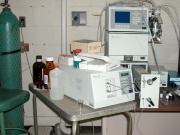Difference between revisions of "High-performance liquid chromatography"
m (MDerrick moved page HPLC to High-performance liquid chromatography) |
|||
| Line 2: | Line 2: | ||
== Description == | == Description == | ||
| − | + | An analytical technique that uses a liquid mobile phase to transport and individual compounds in a mixture. High-performance liquid chromatography (HPLC) uses a mechanical pump to pass a pressurized liquid solvent (mobile phase) through a column filled with a solid sorbent material (stationary phase). A liquid sample contained multiple components is injected into the mobile phase. As the sample passes over the stationary phase, the chemical compounds are separated and resolved, via absorption and desorption. The interaction of the solute with mobile and stationary phases is dependent upon the composition of the solvent gradient vs. the stationary phase. These interactions are physical in nature, such as hydrophobic (dispersive), dipole–dipole and ionic, most often a combination. | |
| + | |||
| + | HPLC is an advance version of partition chromatography. Early versions, and school house versions, include paper chromatography and thin layer chromatography. Most commonly, HPLC is useful in the separation of compounds that are too nonvolatile to be separated by gas chromatography. In the cultural heritage area, HPLC is used for the identification of organic dyes. Specialized versions of the technique include Size-exclusion chromatography (used for molecular weight determinations) and Ion-exchange chromatography (used to identify trace components in water). | ||
== Synonyms and related terms == | == Synonyms and related terms == | ||
| − | high performance liquid chromatography | + | HPLC; high performance liquid chromatography; high-pressure liquid chromatography; chromatographie en phase liquide à haute performance (Fr.); Flüssigchromatographie (Deut.); size-exclusion chromatography (SEC); ion-exchange chromatography (IEC) |
==Resources and Citations== | ==Resources and Citations== | ||
* http://www.nga.gov/resources/scienceresearch/glossary.shtm | * http://www.nga.gov/resources/scienceresearch/glossary.shtm | ||
| + | * Wikipedia: [https://en.wikipedia.org/wiki/High-performance_liquid_chromatography High-performance liquid chromatography] (Accessed June 2023) | ||
[[Category:Materials database]] | [[Category:Materials database]] | ||
Revision as of 14:36, 19 June 2023
Description
An analytical technique that uses a liquid mobile phase to transport and individual compounds in a mixture. High-performance liquid chromatography (HPLC) uses a mechanical pump to pass a pressurized liquid solvent (mobile phase) through a column filled with a solid sorbent material (stationary phase). A liquid sample contained multiple components is injected into the mobile phase. As the sample passes over the stationary phase, the chemical compounds are separated and resolved, via absorption and desorption. The interaction of the solute with mobile and stationary phases is dependent upon the composition of the solvent gradient vs. the stationary phase. These interactions are physical in nature, such as hydrophobic (dispersive), dipole–dipole and ionic, most often a combination.
HPLC is an advance version of partition chromatography. Early versions, and school house versions, include paper chromatography and thin layer chromatography. Most commonly, HPLC is useful in the separation of compounds that are too nonvolatile to be separated by gas chromatography. In the cultural heritage area, HPLC is used for the identification of organic dyes. Specialized versions of the technique include Size-exclusion chromatography (used for molecular weight determinations) and Ion-exchange chromatography (used to identify trace components in water).
HPLC; high performance liquid chromatography; high-pressure liquid chromatography; chromatographie en phase liquide à haute performance (Fr.); Flüssigchromatographie (Deut.); size-exclusion chromatography (SEC); ion-exchange chromatography (IEC)
Resources and Citations
- http://www.nga.gov/resources/scienceresearch/glossary.shtm
- Wikipedia: High-performance liquid chromatography (Accessed June 2023)
